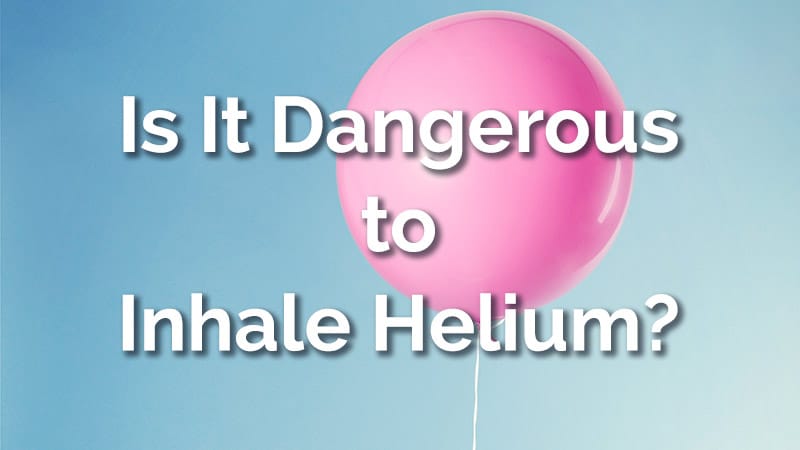Inhaling helium is incredibly popular all over the world. It makes people’s voices sound funny for a short time. Actually, it can be pretty entertaining. Probably that’s the reason for the increasing number of videos of people talking on helium.
Helium-filled balloons (and helium tanks) are extremely widespread party accessories; however, unfortunately not many people are aware of the possible health consequences and dangers of inhaling helium. Things can go wrong if you don’t know what you’re doing.
In this article, you’ll find straightforward answers to all those questions that everyone should ask before inhaling helium. Let’s start with some basic facts about this gas. (If you only want to know if it is safe to inhale helium, just scroll down to the corresponding section.)
What You Should Know About Helium

Helium is an odorless, colorless, tasteless, and non-reactive gas. It’s the second lightest element in the universe (only hydrogen is lighter than helium) and it’s also very abundant. The atmosphere of Earth also contains helium, although in a very low concentration.
Hydrogen and helium are both lighter than air, but while hydrogen is extremely flammable, helium is a non-flammable and non-reactive gas, so it’s a perfect fill for balloons and certain types of airships. Helium is an excellent cryogenic coolant and it’s commonly used for lasers and arc welding too.
What Is Balloon Gas?
Balloons are filled with balloon gas (what a surprise) that is usually a byproduct of the different types of applications of pure helium gas.
Balloon gas is a mixture of helium and other atmospheric gases, including nitrogen, oxygen, and carbon dioxide.
Scientific and medical applications require extremely pure helium, so balloon gas is inappropriate for this purpose. Balloon gas should contain at least 92% helium to ensure that the balloon will fly (1).
What Happens In Your Body When You Inhale Helium?
If we want to know how safe it is to inhale helium, first we should have a closer look at how helium and oxygen behave in the human body.
We all need a constant level of atmospheric oxygen to survive. Adults at rest inhale and exhale 7-8 liters of air on average in every minute. Air contains 21% oxygen, however, we only consume about 25% of the inhaled oxygen and exhale the rest. That means our body uses approximately 550 liters of pure oxygen each day (2).
The human body needs a steady oxygen supply to function properly. Oxygen molecules are carried by the red blood cells to the cells of our body that use oxygen in the process of so-called cellular respiration to generate usable forms of energy. Lack of oxygen can have really serious health consequences. Brain cells (aka neurons) are especially sensitive to reduced oxygen levels. After only 5 minutes of oxygen deprivation, neurons can begin to die (3). However, one may lose consciousness much earlier.
When you inhale helium, it displaces the oxygen molecules in your lungs and causes them to leave the respiratory system faster than they normally would. This can lead to a state of oxygen deprivation within seconds. This is the major danger of inhaling helium.
How Does Helium Change the Sound of Your Voice?
The air you breathe in from a balloon contains mostly helium molecules, so it’s lighter and less dense than normal atmospheric air. That’s why it allows sound to travel much faster across your vocal cords.
So helium does not change the pitch of your voice, it only affects the speed of sound waves, and this is the reason why your voice sounds so funny after inhaling helium.
Make sure you also check out our ultimate list of home safety measures you should take to make your home a much safer place (with printable checklist!).
So Is It Dangerous to Inhale Helium? What Side Effects Can It Have?
Inhaling one or two breaths of helium from a balloon usually won’t cause any permanent health damage in most people (4). However, it’s important to emphasize that inhaling helium is potentially dangerous and can have certain types of side effects, even serious ones. There are many recorded deaths caused by helium inhalation (5).
Side effects of inhaling helium gas can include temporary symptoms, like headache, nausea, lightheadedness, or faintness. However, it can also lead to more severe, even life-threatening conditions, like confusion, asphyxiation, air embolism, or bleeding of the lungs (especially if you inhale helium from a pressurized tank). As you can see, helium inhalation can be a pretty risky business, and more often than not it’s simply not worth the risk.
Does Breathing In Helium Kill Brain Cells?
Your brain uses about 20% of the inhaled oxygen. Comparing the weight proportion of the brain to the whole body, that’s a pretty large amount. Brain cells require oxygen to be able to metabolize glucose which is their primary source of energy. Consequently, in lack of oxygen brain cells can’t produce enough energy from the glucose molecules and they start to get damaged, and eventually die. Low levels of oxygen can cause anything from a headache to confusion (or even death), depending on the severity of the hypoxemia (6).
So, not helium but the lack of oxygen is what damages and kills brain cells. The more helium you inhale, the more likely you will experience oxygen deprivation. Thus, inhaling too much helium is not your safest bet when it comes to brain health.
Can Helium Damage Your Lungs?
Helium gas in itself won’t hurt your lungs, all it does is take oxygen’s place inside your respiratory system. Lack of oxygen can, indeed, damage any tissue (including lungs) in your body.
However, inhaling helium from a high-pressure tank can permanently and seriously damage your lungs. It can rupture lung tissue and cause bleeding. The other danger of inhaling helium from a commercially available pressurized tank is that it can generate helium bubbles that can occlude smaller arteries in your body organs, including your brain. It’s a potentially life-threatening condition.
Can You Die From Inhaling Helium?
In brief: Yes, you can. Inhaling too much helium causes serious oxygen deprivation that can lead to asphyxiation and eventually death. There’s a much higher chance of a fatal consequence when someone inhales helium from a pressurized helium tank because of the higher risk of air embolism and the irreversible lung damages it can cause.
Is It Safe to Inhale Helium From a Balloon?
As we’ve already discussed, balloon gas contains at least 92% helium. Although you will find a small amount of oxygen in balloon gas, it’s practically not enough to provide your body with a sufficient oxygen supply. If you overdo it, you will soon start to feel light-headed and eventually faint because of the lack of oxygen.
So, the answer is no, it’s not completely safe to inhale helium from a balloon, and in some rare cases, it can have really serious, even fatal health consequences (especially in the case of children and older adults or if you inhale too much helium). However, don’t forget that inhaling helium from a pressurized tank can put you at a much higher risk for serious health damage than inhaling balloon gas.
Can Inhaling Helium Get You High?
Helium is not a drug, and it usually does not enter into your bloodstream, except if your lung is injured (because of inhaling helium from a pressurized tank, for instance). There are some reports about getting high with helium, however, it’s not the helium but the consequent lack of oxygen that can sometimes cause a somewhat altered state of mind for a short time.
I must call your attention that trying to get high by inhaling helium is potentially dangerous, you can easily faint or suffer other temporary or permanent injuries (again: inhaling helium can also be deadly).
Summary
Most of us would agree that talking on helium is fun. Although in the vast majority of the cases inhaling helium is not associated with any adverse health effects, you should be aware of the possible consequences.
As you can see, there are many dangers of helium gas inhalation. It’s never completely safe to inhale helium, even if you inhale it from a balloon. It causes oxygen deprivation in your body which can be really hazardous in certain cases. Inhaling helium can be especially dangerous for kids, seniors, and those with some kind of lung problem. You should never try inhaling helium from a pressurized tank as it can permanently damage your lungs.
Always pay special attention to kids and don’t let them inhale helium from balloons as they’re more vulnerable than adults. Also, make sure you always keep helium gas tanks out of reach of children. Remember: buying helium tanks and balloons are legal, however, they’re only safe when used properly. Always keep in mind the dangers of misusing helium to prevent accidents and injuries.











